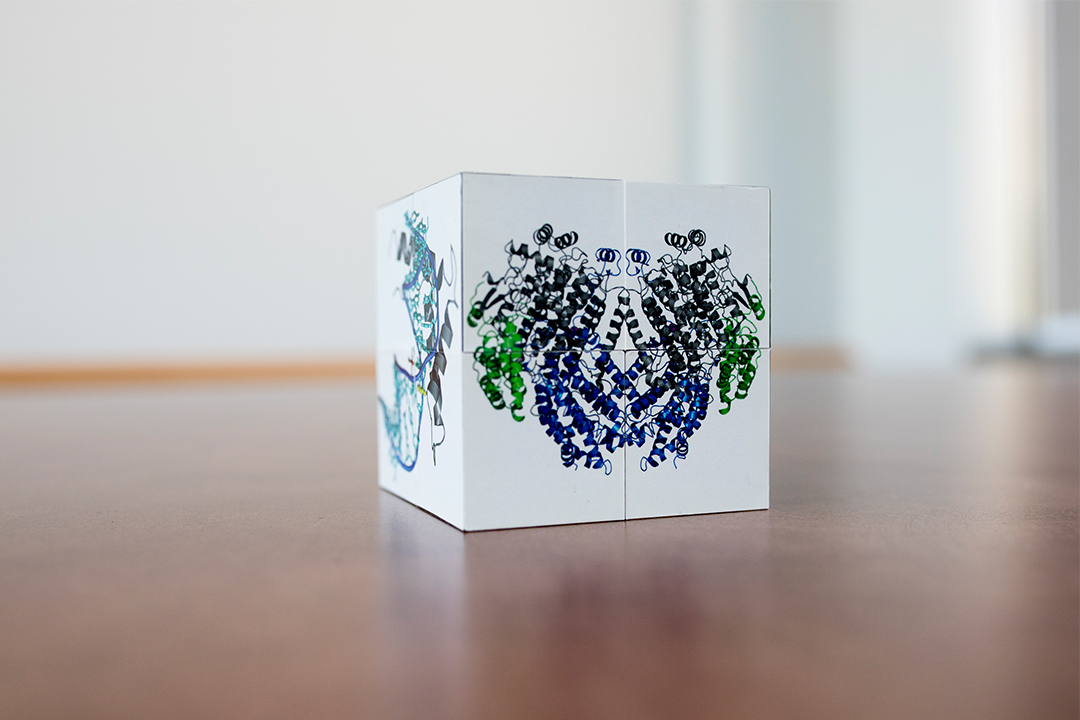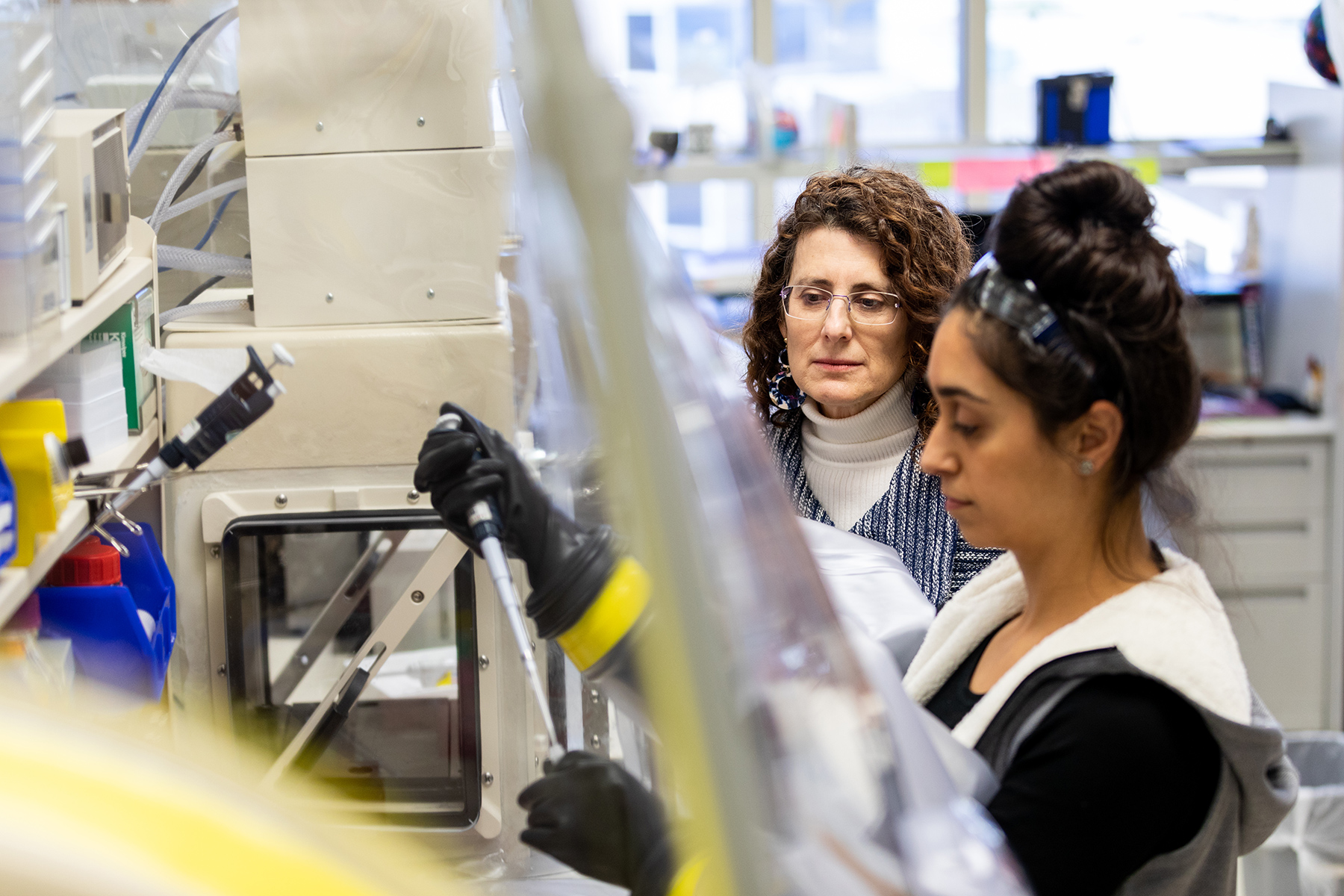The Science of Learning
Northwestern professors share how we successfully learn information — and how we can better retain it.
Amy Rosenzweig studies how proteins and metals interact in the human body and in the environment. By Monika Wnuk
Amy Rosenzweig picks up a Rubik’s Cube–like paperweight with a colorful, spiral structure printed on one side.
“This side commemorates that I determined the complicated structure of a protein in graduate school, which ended up launching my career in chemistry,” says Rosenzweig, who holds joint appointments in chemistry and molecular biosciences in Northwestern’s Weinberg College of Arts and Sciences.
The ribbon-like picture is a rendering of a protein structure, she explains. Each chain represents a three-dimensional arrangement of atoms in amino acids, the building blocks of proteins.

Commemorative cube recognizing the protein structure Amy Rosenzweig determined in graduate school.
Proteins play many critical roles in the human body, including fighting off viruses and bacteria, building tissues and organs, and regulating gene expression. And because proteins are at the center of so many important functions, they are also central to understanding all types of disease.
Throughout her career, Rosenzweig has zeroed in on the relationship between proteins and metals such as copper and iron— both in the human body and in the environment.
“Many diseases are linked to abnormal metal metabolism, having too much or too little of a crucial metal,” says Rosenzweig, “and it’s also been shown that there’s an interplay between bacteria, metals and proteins that causes infection in the body.”
In 2003 Rosenzweig was named a MacArthur Foundation Fellow for her work studying the role of metal metabolism in diseases such as Lou Gehrig's disease, or amyotrophic lateral sclerosis. Since then, she has continued this line of work, adding to it an exploration of the development of treatments for diseases resulting from metal overload.
“Receiving the MacArthur award was a nice validation that the work I’m passionate about is worth exploring and can make a difference in the world,” she says.
Another track of Rosenzweig’s work has sought to understand the mechanism through which bacteria convert methane, a harmful greenhouse gas, to methanol, a useful and “green” fuel that can be used to power cars and generate electricity, among other applications.
Known as methanotrophs, methane-eating bacteria have long been known to make methanol in the first step of their metabolism, but the mechanism of this chemical reaction was not previously known.
Rosenzweig discovered that the primary enzyme responsible for the methane-to-methanol conversion performs this reaction at a site that contains a single copper ion. That discovery could allow the conversion to be replicated at scale.
Industrial processes for methane-to-methanol conversion exist currently, but only in conditions of extreme heat and pressure, requiring costly upkeep. Rosenzweig’s work offers a natural alternative that operates at room temperature, eliminating previous barriers to entry.
“Methane has played an increasingly critical role in climate change, and even more so recently because hydraulic fracturing releases a lot of methane gas,” she says. “The need for solutions grows greater every day.”

In 2017 Rosenzweig was elected to the National Academy of Sciences, another notch in her belt of impressive achievements. The honor was personally significant, as it allowed her to follow in the footsteps of many of her professional role models, including Judith Klinman, the first female physical scientist to be hired by the University of California, Berkeley, in 1978, and a force in the field of biochemistry.
In the 1990s, Klinman discovered that her salary was much lower than that of her male colleagues, highlighting the need for increased transparency and wage equality in the field. Her message resonated with female scientists everywhere — and still sticks with Rosenzweig today.
“In the sciences, we have not solved the problem of having fewer women in the pipeline or of wage disparities between male and female researchers,” she says.
When reflecting on what it might take to make positive change in the field, Rosenzweig considers a word with significant, and specific, meaning in her field — catalyst.
“The scientific definition of a catalyst is something that changes the activation energy of a reaction to make it easier — either by raising the starting point or changing the pathway involved in getting there,” says Rosenzweig. “When it comes to catalyzing the prevalence of women in the field, I think the more women we support in the field and the more pathways we create for women to succeed, the easier it will be to be for future generations to get across barriers.”
Reader Responses
No one has commented on this page yet.
Submit a Response